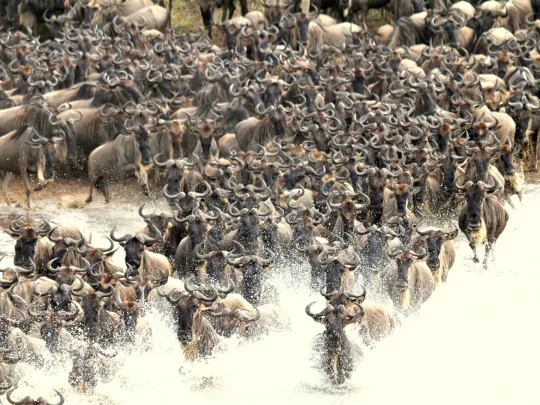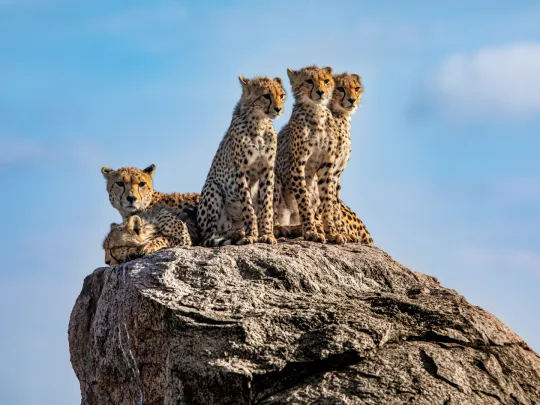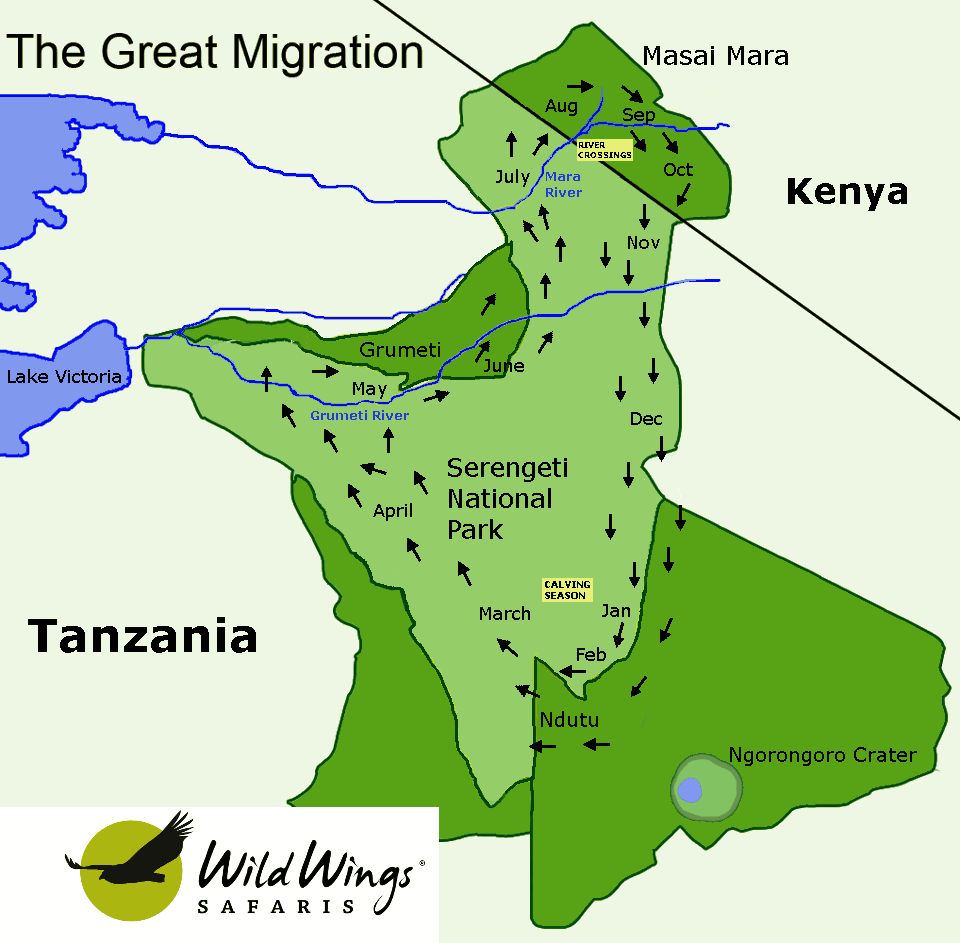Tanzania Travel Guide
Tanzania Travel Guide
Tanzania is one of Africa's top safari destinations, known for its vast landscapes, diverse wildlife and iconic parks. From the endless plains of the Serengeti to the unique Ngorongoro Crater, Tanzania delivers some of the most rewarding game-viewing experiences on the continent. It's also easy to combine a northern Tanzania safari with a relaxing beach holiday in Zanzibar. For seasoned travellers looking to go off the beaten track, the wild and remote southern and western regions offer untouched wilderness and fewer crowds.
Highlights
- Witness the Great Wildebeest Migration: Experience one of nature's most dramatic spectacles as over a million wildebeest and zebra traverse the Serengeti during the annual Great Migration in Tanzania.
- Explore the Iconic Serengeti National Park: Discover endless plains teeming with wildlife, big cats and year-round game viewing in Tanzania's flagship safari park — the world-famous Serengeti.
- Descend into the Ngorongoro Crater: Visit the world's largest intact volcanic caldera, home to an astonishing concentration of wildlife, including all Big Five species.
- Go on Safari in Tarangire and Lake Manyara: Spot huge elephant herds among ancient baobab trees in Tarangire National Park, and enjoy flamingo-filled shores and forest landscapes in Lake Manyara.
- Climb Mount Kilimanjaro: Take on the challenge of Africa's highest peak and summit the legendary Mount Kilimanjaro, a bucket-list trek for adventurers and high-altitude hikers.
- Unwind on Zanzibar's White-Sand Beaches: After your safari, relax on the tropical shores of Zanzibar Island, a beach paradise with turquoise waters, coral reefs, and rich Swahili culture.
- Escape to the Wild South – Selous & Ruaha: Discover off-the-beaten-track safaris in Tanzania's Southern Circuit, where vast wilderness, fewer tourists, and unique activities like boat safaris await.
- Trek with Chimpanzees in Mahale Mountains: Head west for a truly remote experience — chimpanzee trekking in Mahale Mountains National Park offers rare encounters in one of Africa's most pristine settings.
Northern Safari Circuit

Dramatic scenes at a river crossing in the Serengeti
Tanzania's Northern Safari Circuit is the main destination for most safari visitors, with a well-developed infrastructure, excellent lodges and consistent wildlife viewing. The town of Arusha is the gateway to this region, and most safari operators are based here. The circuit includes Tarangire, Lake Manyara, the Ngorongoro Crater and the world-famous Serengeti National Park.
Just a two-hour drive from Arusha, Tarangire National Park is known for its ancient baobabs, scenic savannah and large elephant herds. It's especially rewarding in the dry season (June to October), when wildlife concentrates around the Tarangire River. If time allows, this is an excellent first stop, with a good selection of safari camps and lodges.
Often visited en route to Ngorongoro or Serengeti, Lake Manyara is best known for its flamingos, diverse birdlife and lush groundwater forest. While small and not a top game-viewing destination, it offers sightings of buffalo, elephant, giraffe, zebra and the occasional lion. Most visitors stay in nearby lodges on the escarpment and explore the park on a full or half-day game drive.
The Ngorongoro Crater is a spectacular natural amphitheatre, with a high-altitude rim and fertile floor teeming with wildlife — including all Big Five species. The town of Karatu is the main hub for visitors, but several high-end lodges are perched right on the rim. One or two days is usually enough to explore the crater.
The wider Ngorongoro Conservation Area extends west to Ndutu, a favourite for the migration calving season (January to March). The region is shared with the Maasai, who continue to graze cattle in traditional ways, adding a rich cultural dimension.
Serengeti National Park is Tanzania's flagship safari destination and home to the Great Migration — a seasonal movement of over a million wildebeest, accompanied by zebras and predators. From dramatic river crossings to wide open plains filled with game, the Serengeti is unmatched in scale and spectacle.
Game viewing is excellent year-round in central areas like Seronera, but the best time to catch the migration depends on the season. A minimum of three nights is recommended; six nights in two regions is ideal. For more, see our detailed Serengeti Migration Guide.
Africa's highest peak, Mount Kilimanjaro, attracts climbers from around the world. At nearly 6,000 metres, this dormant volcano is not a casual trek and requires both preparation and several days to summit. If climbing Kilimanjaro is on your list, we can connect you with a reputable operator who specialises in guided expeditions.
Southern Safari Circuit

Boating safari in Nyerere National Park
The Southern Circuit is more remote and less visited. It's accessible via Dar es Salaam, Tanzania's largest city. Key safari parks in the south include Selous Game Reserve, Ruaha National Park, and Mikumi.
This small but scenic reserve north of Selous makes a convenient first stop if you're starting your safari from Dar. It's also the base for visiting Udzungwa Mountains National Park, which offers great hiking and biodiversity.
Formerly Selous, Nyerere National Park is one of Africa's largest reserves. Only its northern section is open to tourists, but it offers a wild and uncrowded experience. Unlike other national parks, you can do boat safaris, walking safaris, and off-road game drives here. However, game is more spread out, so it may not suit first-time safari-goers seeking quick sightings.
Ruaha is one of Tanzania's best-kept secrets. Accessible only by flight, it boasts dramatic scenery, high predator densities, and minimal crowds. Most wildlife concentrates along the Ruaha River during the dry season (June to October), when game viewing is at its best.
Western Tanzania

The chimpanzees of Mahale Mountains
Tanzania's remote western frontier remains one of the least visited safari regions in East Africa — and that's exactly what makes it so special. Isolated and pristine, the west is home to two of the country's most extraordinary parks: Mahale Mountains National Park and Katavi National Park. While both are expensive and logistically challenging to reach, they offer a rare, off-the-beaten-track safari experience for those seeking true wilderness, exceptional wildlife encounters, and almost no crowds.
Nestled on the shores of Lake Tanganyika, Mahale Mountains is one of the best places in Africa for chimpanzee trekking in the wild. The park's dense forests are home to habituated chimp families, which can often be found and observed on guided hikes through the jungle. Mahale is also incredibly scenic — picture remote white-sand beaches, crystal-clear water, and rainforest-covered peaks — making it as beautiful as it is biologically rich.
Often described as Tanzania's undiscovered safari gem, Katavi offers an old-fashioned, crowd-free safari with abundant wildlife and expansive floodplains. The park sees remarkably few visitors each year, yet supports impressive populations of elephant, hippo, lion, buffalo and crocodile, especially during the dry season when water is scarce. If you're looking for raw, untamed Africa, Katavi delivers it in spades.
Zanzibar and the Coast

Tropical paradise of Zanzibar
Most safaris end with a few days of relaxation, and Zanzibar is the top beach destination in Tanzania. This Indian Ocean island has white sandy beaches, turquoise water, and a fascinating cultural mix of Swahili, Arab and Indian influences. You'll find everything from budget guesthouses to luxury beachfront resorts. Other beach options include Pemba Island and the Tanzania mainland coast.
Climate and Weather
Tanzania lies in the tropics and is generally hot and dry in the dry season, and warm and humid in the wet season. The short rains fall from late October to December, and the long rains from March to May (with April the wettest). Some lodges close during the wettest months.
When to Go
Tanzania is a year-round destination, but the best time depends on what you want to see. For birders, December to March is ideal. This is also when the Great Migration calving occurs in the southern Serengeti. Peak safari season is the dry period from June to October, when wildlife is easier to spot. Migration river crossings in the north are typically seen around July to September.
Lake Manyara National Park

The spectacular alkaline Lake Manyara forms the centre point of this small and very beautiful park with surprisingly diverse fauna and flora. A circuit drive through the park passes through forest, wetlands, grassy plains and acacia forests, offering views of different animals and multitudes of birds. Elephant, hippo, giraffe, tree-climbing lion and baboon are just a few of the game that call Manyara home.
Arusha National park

Don't be fooled by the fact that Arusha National Park is small (552 km2). Within its borders, it has a diverse topography and wonderful wildlife. From the rugged peaks of Mount Meru to the marshy depths of the Ngurdoto Crater where warthog wallow, to monkey-filled montane forest and rolling grassy hills on which giraffe and zebra graze, there's plenty to see here.
Tarangire National Park

Tarangire National Park is traversed by the Tarangire River which never dries up. Being the only source of water during the dry season from July to October, it draws hundreds of animals to the park, making for spectacular wildlife and bird spotting. The landscape is varied, with grassy savannahs, swamps, hills and spectacular baobabs.
Ngorongoro Crater

Ngorongoro is a Tanzanian must-see. The Ngorongoro Crater, a caldera or collapsed volcano, while only covering 260 km², includes a diverse range of habitats including montane forest, grasslands, acacia forests, a salt-lake and swamps. The diversity of the habitat provides refuge to an incredibly wide range of birds and animals, including the Big Five, in a concentrated area. Accommodation around the rim of the crater provides spectacular views and easy access to the crater.
Ndutu Region

Consisting mainly of sweeping grasslands, the Ndutu area in the northern part of the Ngorongoro Conservation Area joins the Serengeti. As such, it forms part of the annual migratory route of hundreds of thousands of wildebeest, zebra, antelope and their predators who come to graze and calve between November and March, depending on the rains. The forests around Lake Ndutu and small koppies are also home to prolific resident wildlife.
Serengeti National Park

Covering a vast area in northwestern Tanzania, the Serengeti National Park is an absolute bucket-list destination. With over 70 mammals, including huge populations of lions and other predators and over 500 bird species, this is a wildlife viewing paradise. Beyond the incredible Great Wildebeest Migration that moves through the area seasonally, the Serengeti is an incredibly beautiful park with diverse flora and fauna.
Serengeti Migration Area

The Greater Serengeti Migration Area refers to a huge area that incorporates a number of national parks, including Serengeti and the Ndutu region of Ngorongoro. Vast plains, rolling hills, volcanic mountains and forested areas make for breathtaking scenery. Add to that abundant wildlife and the annual migration through the region of millions of wildebeest, zebra, antelope and their predators, and you have the perfect safari setting.
Mahale Mountain National Park

The Mahale Mountains National Park is situated on the eastern shores of Lake Tanganyika in remote western Tanzania. It's spectacularly beautiful, with the backdrop of the Mahale Mountains and lush, tropical flora. The main attraction is walking safaris to observe the chimpanzees who live here. They share their forest paradise with a range of other primates, mammals and beautiful birds.
Katavi National Park

Known for its diverse landscapes and abundance of game, Katavi National Park's drawcard is its remoteness. This has ensured that the area has remained completely unspoilt. With so few visitors around, a Katavi safari is guaranteed to make you feel like the only people on earth! With large populations of elephants, lions, hippos and more, game viewing is beyond spectacular, especially during the dry season when water sources dwindle.
Zanzibar

Zanzibar Island, along with Pemba Island to the north, are referred to as the Spice Islands. Zanzibar is best known as a tropical beach paradise, which is easily combined with a safari in Tanzania or Kenya. The history here harks back to ancient trade routes. In Stone Town, Indo-Arabic influences intertwine with African Swahili origins to create a heady fusion of sights, sounds and scents. Whether you're looking for the culture and bustle of historic cobbled streets in Stone Town or the peaceful beaches and the warm Indian Ocean with its dhow trips and excellent diving, Zanzibar is simply paradise.
Ruaha National Park

In the heart of Tanzania where the Zambezi miombo woodlands meet the Tanzanian/Kenyan savannahs, lies Ruaha National Park. This vast park, with its few camps, offers visitors an uncrowded glimpse of untouched Africa, with its huge diversity of game, birds and landscapes. It's an area known for its incredible animal sightings, including large herds of elephant and plenty of predators.
Selous Game Reserve

Selous Game Reserve in southern Tanzania covers over 45,000km² and is one of the country's three World Heritage Sites. The reserve is world-renowned for its unspoilt bush and vast numbers of game, including elephant, lion, hippo and over 440 species of bird. Incredible scenery and the option to enjoy the African bush not only on game drives but game walks and boating safaris, too, make Selous an incredible safari destination.
Ngorongoro Crater Region

One of Tanzania's top safari spots, the Ngorongoro Conservation Area offers safari-goers and wildlife enthusiasts outstanding wildlife sightings and breathtaking scenery. A game drive on the floor of the Ngorongoro Crater with its incredibly diverse range of birds and animals including the Big Five is a bucket-list experience on any Tanzanian safari itinerary.
Ngorongoro Karatu Area

Accommodation and park fees within the Ngorongoro Conservation Area can be high. Just 20 km out of the park lies the bustling town of Karatu, surrounded by beautiful coffee plantations. It is here that comfortable, affordable accommodation in spectacular settings can be found. The area enjoys easy access to Ngorongoro, with its breathtaking scenery and teeming wildlife, especially at Ngorongoro Crater.
Arusha

Situated at the foot of the beautiful Mount Meru, Arusha is known as the safari capital of Tanzania's Northern Safari Circuit. It's a bustling city filled with an interesting mix of markets, chaotic traffic, old colonial buildings and modern conveniences, like coffee shops with WiFi, and an array of great restaurants.
You may also want to look at

5 Day Luxury Serengeti Safari
Explore one of the Serengeti's most exclusive regions on this 5-day luxury fly-in safari. Based at Olmara Camp in the Soit le Motonyi area of eastern Serengeti, you'll experience exceptional game viewing in a remote, low-tourist zone known for its high concentration of big cats. This safari includes a scenic domestic flight from Kilimanjaro International Airport near Arusha to Seronera Airstrip in the central Serengeti, four nights in an eco-luxury tented camp, and expertly guided game drives in a wildlife-rich area once closed to tourists.

7 Day Taste of Tanzania Safari Tour
This expertly guided 7-day Tanzania safari showcases the very best of northern Tanzania's wildlife reserves. From the baobab-studded plains of Tarangire to the lush highlands of Ngorongoro Crater and the endless grasslands of the Serengeti, this safari promises close-up encounters with Africa's most iconic species. Depending on the season, you may even witness the Great Migration, one of the world's most spectacular natural events.

9 Day Tanzania Luxury Safari: Tarangire, Ngorongoro, Serengeti & Arusha
Our 9-day Tanzania luxury safari explores the best of East Africa's iconic wilderness areas. From elephant-rich Tarangire to the famous Ngorongoro Crater and the wildlife-thriving plains of the Serengeti, this curated journey offers an exclusive, all-inclusive safari experience. With hand-picked luxury camps and lodges, personalised service, and expert guides, you'll enjoy extraordinary game viewing in comfort and style—with the option to extend your trip to Zanzibar's idyllic beaches.

14 Day Tanzania Bush & Beach Adventure
Experience untamed Africa like never before with a journey through Tanzania's Southern Safari Circuit—a hidden gem offering authentic wildlife encounters far from the bustling crowds of the Northern Circuit. This uncrowded and unspoiled region features the beautiful game reserves of Ruaha, Katavi, and Selous (Nyerere National Park). Finish your adventure with five blissful days at a private tropical island paradise.

14 Day Best of Northern Tanzania & Zanzibar Luxury Tour
This 14-day luxury Tanzania safari and Zanzibar beach tour showcases the very best of Northern Tanzania's legendary safari circuit — including the Serengeti, Ngorongoro Crater and Tarangire National Park — followed by a tropical island escape to one of Zanzibar's most exclusive private beach resorts. With expert guiding, fully inclusive accommodation, and seamless transfers, this curated itinerary delivers an unforgettable bush and beach safari experience.

15 Day Luxury Ngorongoro, Serengeti & Zanzibar Safari
Experience the ultimate East African bucket-list adventure with our 15-Day Luxury Ngorongoro, Serengeti & Zanzibar Safari. This private, fully guided tour takes you to three iconic Tanzanian destinations: the wildlife-rich Ngorongoro Crater, the sweeping plains of the Serengeti, and the pristine shores of Zanzibar. It's the perfect blend of luxury and adventure, tailored for discerning travellers seeking an unforgettable bush and beach experience.



















